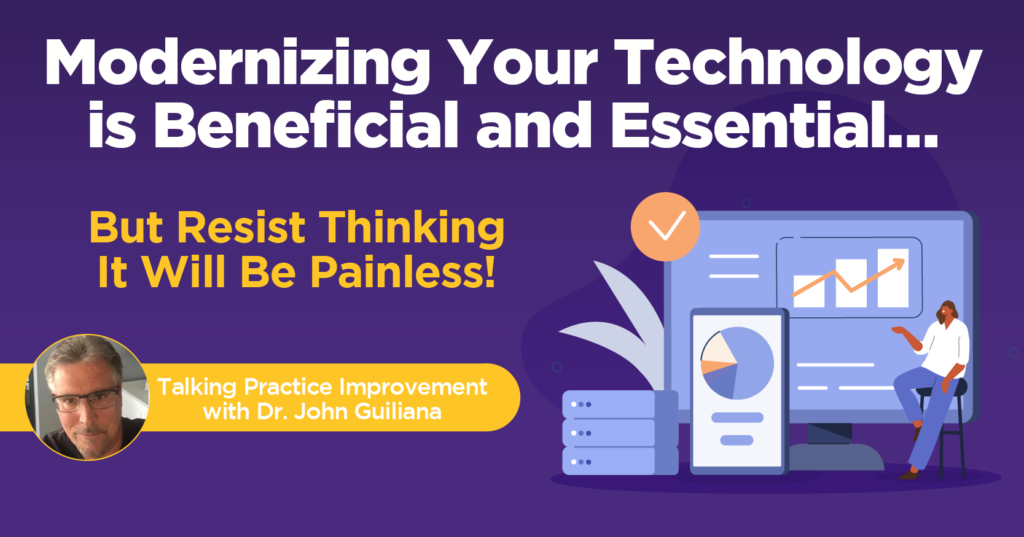Modernizing Your Technology Is Beneficial and Essential…But Resist Thinking It Will Be Painless!

By John V. Guiliana, DPM, MS
Adopting a new electronic health record is often inevitable as the healthcare environment and its demands continuously change. While this endeavor often produces large benefits for the practice’s efficiency, patient communication, and ultimately patient satisfaction, to say it’s an easy task is generally a misrepresentation.
Both adoption failures and successes often have common denominators. Many failures and subsequent adoption struggles can be precluded, however, if some proactive planning is employed.
Setting the Proper Expectations
There’s a common misconception that once a practice recognizes the need to modernize and roll out a new solution, everyone within the organization will take full advantage of the onboarding, training and features of the new technology. In my experience, nothing can be further from the truth. There can be many reasons for adoption resistance, much of which has its root cause in fear.
 According to a Forbes1 study, many people have a fear of the unknown created by the new software. Many fear that their jobs will be negatively impacted by their obvious inadequacy in learning the new software or how it might impact their productivity. It’s therefore essential that every staff member is adequately prepared and informed about the software and what it will ultimately help them accomplish with their jobs. Every organization needs a change leader.
According to a Forbes1 study, many people have a fear of the unknown created by the new software. Many fear that their jobs will be negatively impacted by their obvious inadequacy in learning the new software or how it might impact their productivity. It’s therefore essential that every staff member is adequately prepared and informed about the software and what it will ultimately help them accomplish with their jobs. Every organization needs a change leader.
You: the Change Leader
As a change leader, you can implement some important strategies that help facilitate the adoption of new technology.
1. Initiate communication early
The best way to ensure acceptance and adoption of a change is to include all key users in the decision-making process from the beginning. By doing so, each can assess how the modernized features will affect and assist them in their daily tasks. A good change leader will also set the proper expectations at this point. You should prepare your team for some temporary “planned chaos” and pain points and emphasize how important it will be to keep eyes on the long-term prizes. At the same time, try to get your team members excited about the new features and help them understand how they will ultimately benefit.
2. Tailor the training to the individual
Failures often occur when we expect every member of our team to learn and adopt at the same pace. When people are left behind, they tend to become roadblocks to a successful plan. You know your team the best. I recommend identifying user groups with similar capabilities and setting the pace for their training accordingly and separately.
Be sure to utilize all the pre-go-live learning opportunities possible. As the change leader, you also have the responsibility to make sure that your team is capitalizing on all learning opportunities and sharing its experiences across the organization. Identify anyone falling behind and seek out the root cause.
3. Communicate abundantly
Throughout training, continuously seek feedback from each team member and provide individualized support.
4. Establish checkpoints
Establish individual checkpoints along the learning continuum to confirm your team’s proficiency and identify any weaknesses that might need additional training prior to going live.
5. Seek out advocates
Look for team members who are picking up the adoption quickly and are excited about the change. Empower them to become champions of the new technology and ask them to share their knowledge and excitement with other team members.
6. Transfer ownership
At go live, it’s time to apply everything your team has learned, yet it’s still important to keep them excited about the change. Remember, the learning does not stop with implementation and rollout. Most people will benefit from continuous training through online resources and communities, which will ultimately expand the breadth and depth of their technology knowledge.
Reference
1. Brian Berns, “Driving User Adoption: Making Sure Your Employees Are Engaged Users,” Forbes (2017 Jun 30), forbes.com/sites/forbestechcouncil/2017/06/30/driving-user-adoption-making-sure-your-employees-are-engaged-users/?sh=2f9a6d7e4c1a
This blog is intended for informational purposes only and does not constitute legal or medical advice. Please consult with your legal counsel and other qualified advisors to ensure compliance with applicable laws, regulations and standards.
